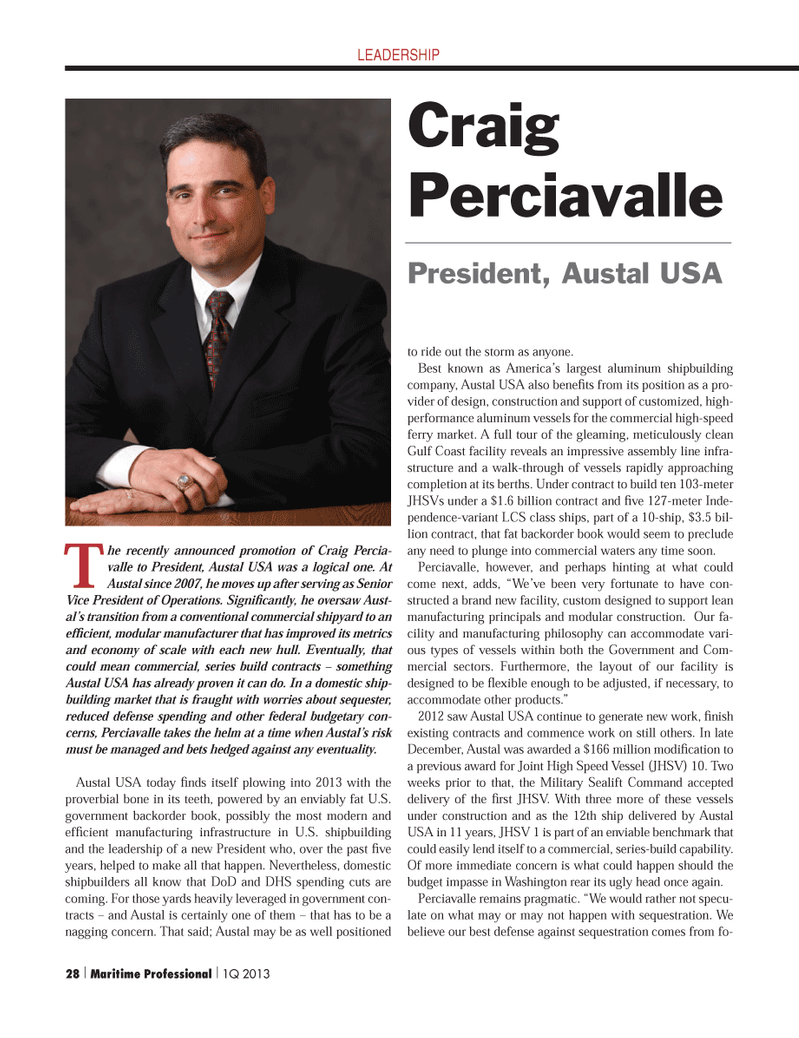
Page 28: of Maritime Logistics Professional Magazine (Q1 2013)
Maritime Risk
Read this page in Pdf, Flash or Html5 edition of Q1 2013 Maritime Logistics Professional Magazine
The recently announced promotion of Craig Percia- valle to President, Austal USA was a logical one. At Austal since 2007, he moves up after serving as Senior Vice President of Operations. SigniÞ cantly, he oversaw Aust- alÕs transition from a conventional commercial shipyard to an efÞ cient, modular manufacturer that has improved its metrics and economy of scale with each new hull. Eventually, that could mean commercial, series build contracts Ð something Austal USA has already proven it can do. In a domestic ship- building market that is fraught with worries about sequester, reduced defense spending and other federal budgetary con- cerns, Perciavalle takes the helm at a time when AustalÕs risk must be managed and bets hedged against any eventuality. Austal USA today Þ nds itself plowing into 2013 with the proverbial bone in its teeth, powered by an enviably fat U.S. government backorder book, possibly the most modern and efÞ cient manufacturing infrastructure in U.S. shipbuilding and the leadership of a new President who, over the past Þ ve years, helped to make all that happen. Nevertheless, domestic shipbuilders all know that DoD and DHS spending cuts are coming. For those yards heavily leveraged in government con- tracts Ð and Austal is certainly one of them Ð that has to be a nagging concern. That said; Austal may be as well positioned to ride out the storm as anyone. Best known as AmericaÕs largest aluminum shipbuilding company, Austal USA also beneÞ ts from its position as a pro- vider of design, construction and support of customized, high-performance aluminum vessels for the commercial high-speed ferry market. A full tour of the gleaming, meticulously clean Gulf Coast facility reveals an impressive assembly line infra- structure and a walk-through of vessels rapidly approaching completion at its berths. Under contract to build ten 103-meter JHSVs under a $1.6 billion contract and Þ ve 127-meter Inde- pendence-variant LCS class ships, part of a 10-ship, $3.5 bil- lion contract, that fat backorder book would seem to preclude any need to plunge into commercial waters any time soon. Perciavalle, however, and perhaps hinting at what could come next, adds, ÒWeÕve been very fortunate to have con- structed a brand new facility, custom designed to support lean manufacturing principals and modular construction. Our fa- cility and manufacturing philosophy can accommodate vari- ous types of vessels within both the Government and Com- mercial sectors. Furthermore, the layout of our facility is designed to be ß exible enough to be adjusted, if necessary, to accommodate other products.Ó 2012 saw Austal USA continue to generate new work, Þ nish existing contracts and commence work on still others. In late December, Austal was awarded a $166 million modiÞ cation to a previous award for Joint High Speed Vessel (JHSV) 10. Two weeks prior to that, the Military Sealift Command accepted delivery of the Þ rst JHSV. With three more of these vessels under construction and as the 12th ship delivered by Austal USA in 11 years, JHSV 1 is part of an enviable benchmark that could easily lend itself to a commercial, series-build capability. Of more immediate concern is what could happen should the budget impasse in Washington rear its ugly head once again. Perciavalle remains pragmatic. ÒWe would rather not specu- late on what may or may not happen with sequestration. We believe our best defense against sequestration comes from fo- Craig Perciavalle President, Austal USA LEADERSHIP28 | Maritime Professional | 1Q 2013MP #1 18-33.indd 28MP #1 18-33.indd 282/22/2013 11:03:15 AM2/22/2013 11:03:15 AM

 27
27

 29
29
